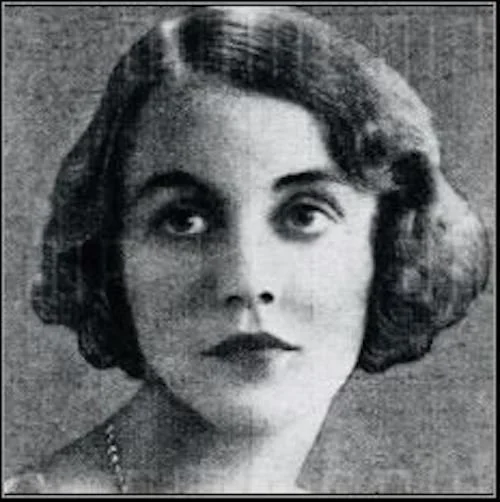Lost Films: An Elastic Affair
Written by Rachael Crawley
A “lost film” has no known existing copies. In most cases, none will ever be found. This series aims to discuss lost movies from across the ages, and to highlight the reasons for film loss and the continuing efforts to counteract it. It is estimated that 90% of all movies made before 1929 are gone forever.
Even the most famous silent filmmaker can have large gaps missing from their career. When it comes to Alfred Hitchcock, it’s astonishing how much of his work still exists. His debut Number 13 was never finished, and has turned up only a few stills. Of his completed features, only The Mountain Eagle is gone, and the archivists of the film world are in hot pursuit of any existing copies. Much of his work as an art director or title designer is lost, but as a director, his filmography is remarkably complete.
And then we have An Elastic Affair.
This movie is not so much a film as a promotional stunt, or as Alain Kerzoncuf and Charles Barr suggest, an extended screen test1. As the 1930s began, British International Pictures conducted a talent search for their next big stars, in collaboration with the magazine Film Weekly. After much publicity and a great number of applicants, Aileen Despard and Cyril Butcher were chosen as winners. According to Kerzoncuf and Barr, the prize was £250 (an astronomical sum, around £17,000 in 2021) and an exclusive contract to work for six months with British International. Hitchcock himself is believed to have been one of the judges2.
The film was first shown on January 19, 19303, in a ceremony the Palladium Theatre in London. Imagine looking for the montage films that are put out at the Oscars every year – this film had about the same range of exhibition, minus the existence of television. Butcher and Despard, of course, were the stars. We know it was a comedy of about ten minutes (one source of the time says four), but have no plot details – though its reception was “enthusiastic” at its few screenings4. It was a talkie, but exhibited as a silent film due to the Palladium’s lack of sound wiring5 – its Ipswich screening may or may not have had sound capacity. The two performances were well-received, though the source quoted appears to be in the “fawning press” camp of things. Another source considers Butcher’s presence to be “amateurism”, though this is chalked up to his lack of experience6. Interestingly, Kerzoncuf and Barr question whether Hitchcock directed the movie at all. In this era, he was perhaps best described as a working director, rather than the great auteur he would eventually be. Though he worked for British International at the time, and was clearly part of this competition, it is unclear whether he or another studio director actually put this movie together7.
Personally, from the source they include, I suspect Hitchcock was the filmmaker. The clipping dates from January 4, 1930. It includes two photos, one of the nine finalists (including Despard and Butcher) and another of Despard with Hitchcock and the editor of Film Weekly. As the caption states that the winners would be announced January 18, and the ceremony was on January 19, the film would have had to be prepared ahead of time. Why would Hitchcock be included in these photos if he had not been involved with the short? Though he was a prominent director at this point, he was by no means extremely famous. We will probably never know the answer, but all hints suggest that Hitchcock was the one in the director’s chair.
Frustratingly, though, sources on this film are incredibly difficult to find. A few photos exist on IMDB, but I am unsure whether they are really connected to this piece – one is apparently from Number 13, another seems to have different actors, and one appears to depict Despard with Hitchcock, though without the film itself, it’s hard to corroborate. The film is mostly thrown into Alfred Hitchcock’s filmography with no description, except perhaps “lost”. There was a small listing on the British Film Institute’s website, which describes the circumstances in which the film was made. Since it was such a limited exhibition, there are no posters. I could not turn up any press releases on my own, though Kerzoncuf and Barr managed to include a few in their book. Though the competition was well-publicized, An Elastic Affair appears to be an limited piece, meant to be viewed only within this very particular context. It had an additional screening in Ipswich (Butcher’s hometown, which they played up), paired with Jeanne Eagels’ The Letter (so high-profile!)8, but does not seem to have been exhibited commercially as a cinematic short – even though such things were common at the time and would have made sense.
Did you know? Typical feature film screenings of the silent era and Golden Age included newsreels and short films, both live action and animated. Not surprisingly, feature films are the stereotypical focus of film preservation. However, additional material, as well as the film experience itself, have increasingly been part of preservation efforts. On another note, previews for upcoming films were originally screened after the main event – hence why we call them “trailers”.
By far the best source is – you guessed it – Kerzoncuf and Barr’s Hitchcock Lost and Found: The Forgotten Films, the only extensive writing I have found on this topic. The book describes the circumstances surrounding An Elastic Affair in great detail and provides additional context on British filmmaking of the era, as well as the subsequent career of Aileen Despard. Their sources are mostly cobbled from press releases of the time, as well as a few Hitchcock film listings. Happily, unlike many film texts, it is readily available on Kindle. (As film scholars know, the most dreaded words one can hear, besides “this film is considered lost”, are “out of print”.)
So what happened to our plucky young stars? During the competition, there were some over-the-top “puff pieces” written about Despard, who appears to have received the most attention initially. She had a cameo as a murder victim in Hitchcock’s Murder! (1930). The same year, they were slated to appear in Alexander Esway’s Children of Chance, starring Elissa Landi, though only Despard seems to be listed in the credits. Despard retired from film to raise a family9, with her last credit in 1932 per IMDB. Butcher continued to work as an actor and director, even into the television era. His long-term partner was the author Beverley Nichols. From the get-go, he appeared to regard An Elastic Affair as fluff, stating that “I hope to do something better” at the film’s Ipswich screening10. From the sound of it, he fulfilled that dream.
By the end of the decade, Hitchcock was firmly ensconced in Hollywood and well on his way to becoming an all-time great. His American work often overshadowed those early years in Britain. Not only did he produce some great movies during this time, his career offers some insight into the British film industry of the time. An Elastic Affair was a publicity creation, inflated for the sake of drumming up some press and – hopefully – building up a new star or two. While both actors did have careers after this, it is chiefly known today for Hitchcock’s involvement, the extent of which is apparently disputed. Its merits as a film are pretty tenuous. Were it to resurface, however, it could be one more step towards making the Hitchcock filmography complete.
Footnotes
1. Kerzoncuf, Alain and Charles Barr. Hitchcock Lost and Found: The Forgotten Films. Kindle Edition, University Press of Kentucky, 2015. 85.
2. Kerzoncuf and Barr, 80.
3. Giblin, Gary. Alfred Hitchcock’s London: A Reference Guide to Locations. Ebook edition, Midnight Marquee & Bear Manor Media, 2006.
4. Kerzoncuf and Barr, 82.
5. Kerzoncuf and Barr, 83.
6. Ibid.
7. Kerzoncuf and Barr, 80.
8. Kerzoncuf and Barr, 84.
9. Kerzoncuf and Barr, 82.
10. Kerzoncuf and Barr, 84.
Rachael Crawley holds a Master's Degree in Film and Photography Preservation and Collections Management from X University (formerly known as Ryerson), and has worked with film in Canada and in Europe. She adores language and cinema, and how these subjects interact with each other.





